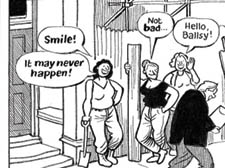|
|
 |
| |

Posy Simmonds' observations from front line of gender conflict |
Life’s tragedy stripped bare
Posy Simmonds has long kept her sharp focus on the trials and tribulations of the urban middle classes, writes Dan Carrier
NEWSPAPERS have their own style, and if you had to define the Guardian’s, you would have to put in the artwork of Posy Simmonds.
Working at the paper since the mid-1970s, her stories reflect the times they were written in and now an exhibition at the Guardian’s King’s Cross headquarters reveals 30 years of Posy’s illustrations. It was a trip down memory lane, says the illustrator.
“Putting it together reminded me of a lot of work I had actually forgotten I had done,” she says.
“It was really weird seeing it all again.”
Posy first started at the Guardian doing occasional illustrations. She was a freelancer, and although her career is intrinsically linked with the paper she has always remained so. Before the Guardian, she had drawn for the Sun.
“It had just been sold to a man we knew little about called Murdoch,” she jokes.
In the 1980s, she created the archetypal Guardian couple in George and Wendy Weber. She enjoyed illustrating their lives: they were a typical north London middle-class, liberal couple: she a nurse and he a sociology lecturer at a polytechnic. “I liked writing it,” she admits.
“They had a very un-tidy house – I like drawing mess and clutter.”
Posy grew up in Berkshire near an American air force base and recalls the children there would bring Stateside comics into school.
“I was into Beano, Dandy, Topper and The Eagle, but I also read American comics like Superman, too,” she recalls.
As a young woman, she studied at the Sorbonne, and noted the esteem in which comics and graphic novels were held on the Continent.
“In Britain and America, comics have always been for children, something we grow out of. In France, it was extraordinary to see adults reading comics. It is huge in Europe,” she says.
Her strip “The Late Gemma Bovery” ran daily in the paper and was later re-issued as a book.
“Someone said to me, ‘look, you’ve written a graphic novel’. But in fact I’d written a serial.”
Posy had to marry the telling of the story with the restrictions of space dictated by the paper’s layout.
Her storyboard was three panels long, and that meant a constant challenge to get the balance right.
“How you tell the story is very much dictated by the space in the paper,” she says.
“If I had been writing a graphic novel I could have as many pages as I wanted.”
It lead on to her celebrated soap opera Tamara Drewe.
Both Tamara Drewe and Gemma Bovery draw on classics. Bovery is an update of Gustave Flaubert, while Drewe is based on Thomas Hardy.
“They are tragic,” she says.
“Perfect material for comic strips.”
• |

|
 |
|
 |
|

